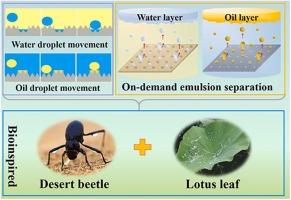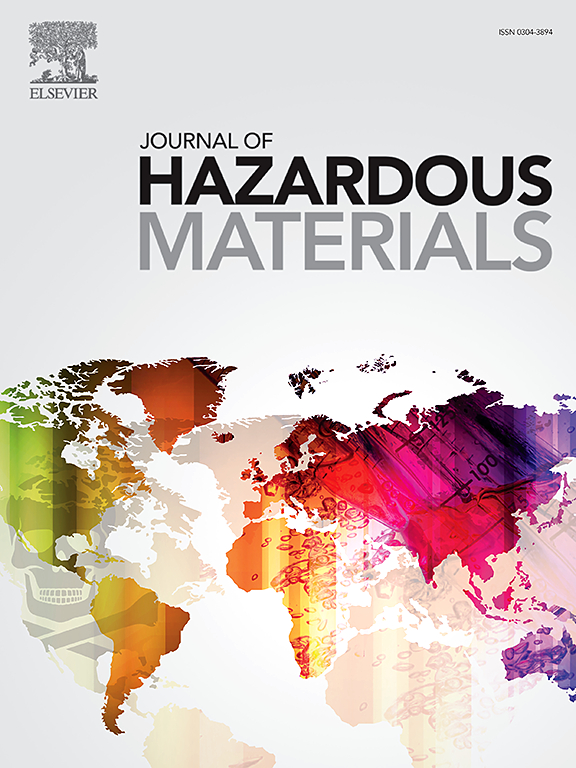Bioinspired interlaced wetting surfaces for continuous on-demand emulsion separation
IF 12.2
1区 环境科学与生态学
Q1 ENGINEERING, ENVIRONMENTAL
引用次数: 0
Abstract
Maintaining high separation performance during continuous emulsion separation remains a challenge. Herein, based on biomimetic coupling ideas, hole array interlaced wetting surfaces (HAIWSs) and mastoid array interlaced wetting surfaces (MAIWSs) were prepared by laser processing, electroless silver deposition, thiol modification, and spraying for on-demand emulsion separation. When the separation is going on, randomly moving emulsion droplets are prone to being captured by holes or mastoids due to interlaced wettability. Under this unique interface behavior, the occurrence of filter cake and pore clogging is reduced, thus achieving both high efficiency (~99.5 and ~99.3%). Meanwhile, the high flux can also be maintained (~3212 and ~3458 L m-2 h-1). Significantly better than surfaces without pores or mastoid structures. Further, the as-prepared surfaces also exhibit excellent recyclability. After 50 separation cycles, optimized HAIWS and MAIWS still maintained high efficiency (~96.2 and ~95.8%) and high flux (~3042 and ~3164 L m-2 h-1), exceeding other surfaces without hole or mastoid structure. Notably, complex physical/chemical cleaning processes are avoided. Besides, even in harsh conditions, HAIWS and MAIWS still maintain excellent stability. The above strategy provides a novel mechanism for effective on-demand emulsion separation and is expected to encourage the creation of new-class separation devices for oily wastewater treatment in industry.

用于连续按需乳液分离的生物启发交错润湿表面
在连续乳液分离过程中保持较高的分离性能仍然是一项挑战。本文基于仿生耦合思想,通过激光加工、无电沉银、硫醇改性和喷涂制备了孔阵列交错润湿表面(HAIWS)和乳突阵列交错润湿表面(MAIWS),用于按需乳液分离。在分离过程中,由于交错润湿性,随机移动的乳液液滴很容易被孔或乳突捕获。在这种独特的界面行为下,滤饼和孔隙堵塞的发生率会降低,从而实现高效率(~99.5% 和 ~99.3%)。同时,还能保持高通量(~3212 和 ~3458 L m-2 h-1)。明显优于没有孔隙或乳突结构的表面。此外,制备的表面还具有出色的可回收性。经过 50 次分离循环后,优化的 HAIWS 和 MAIWS 仍能保持高效率(~96.2% 和~95.8%)和高通量(~3042 和~3164 L m-2 h-1),超过其他无孔或乳突结构的表面。值得注意的是,它避免了复杂的物理/化学清洗过程。此外,即使在恶劣的条件下,HAIWS 和 MAIWS 仍能保持出色的稳定性。上述策略为有效的按需乳化液分离提供了一种新的机制,有望促进工业含油废水处理领域新型分离设备的诞生。
本文章由计算机程序翻译,如有差异,请以英文原文为准。
求助全文
约1分钟内获得全文
求助全文
来源期刊

Journal of Hazardous Materials
工程技术-工程:环境
CiteScore
25.40
自引率
5.90%
发文量
3059
审稿时长
58 days
期刊介绍:
The Journal of Hazardous Materials serves as a global platform for promoting cutting-edge research in the field of Environmental Science and Engineering. Our publication features a wide range of articles, including full-length research papers, review articles, and perspectives, with the aim of enhancing our understanding of the dangers and risks associated with various materials concerning public health and the environment. It is important to note that the term "environmental contaminants" refers specifically to substances that pose hazardous effects through contamination, while excluding those that do not have such impacts on the environment or human health. Moreover, we emphasize the distinction between wastes and hazardous materials in order to provide further clarity on the scope of the journal. We have a keen interest in exploring specific compounds and microbial agents that have adverse effects on the environment.
 求助内容:
求助内容: 应助结果提醒方式:
应助结果提醒方式:


